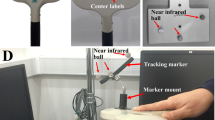Abstract
Purpose
In Transcranial Magnetic Stimulation (TMS), the principle of magnetic induction is used to stimulate the brain non-invasively. Currently, robotic TMS systems are developed to guarantee precise coil placement on the head and in this way achieve the repeatability of stimulation results. However, usability concerns such as the complicated coil positioning are still unsolved for motion compensated robotized TMS. In this paper, we demonstrate the integration of a force-torque control into a robotic TMS system to improve usability, safety, and precision.
Methods
We integrated a force-torque sensor between robot effector and TMS coil. Coil calibration and gravity compensation have been developed. Based on them, we have implemented hand-assisted positioning for easy and fast coil placement. Furthermore, we have enhanced the existing motion compensation algorithms with a contact pressure control.
Results
The positioning time for an experienced user decreased up to 40% with the help of hand-assisted positioning in comparison with not hand-assisted robotized positioning. It also enabled an inexperienced user to use the system safely.
Conclusion
Integration of a force-torque control into the motion compensated robotized TMS system greatly enhances system’s usability, which is a prerequisite for integration in the clinical workflow and clinical acceptance.
Similar content being viewed by others
References
Albu-Schäffer A, Haddadin S, Ott C, Stemmer A, Wimböck T, Hirzinger G (2007) The dlr lightweight robot—design and control concepts for robots in human environments. Ind Robot 34(5): 376–385
Awiszus F (2003) Tms and threshold hunting. Suppl Clin Neurophysiol 56: 13–23
Chronicle EP, Pearson AJ, Matthews C (2005) Development and positioning reliability of a tms coil holder for headache research. Headache: J Head Face Pain 45(1): 37–41. doi:10.1111/j.1526-4610.2005.05008.x
Ernst F, Richter L, Matthäus L, Martens V, Bruder R, Schlaefer A, Schweikard A (2012) Non-orthogonal tool/flange and robot/world calibration for realistic tracking scenarios. Int J Med Robot Comput Assist Surg p (accepted for publication)
Lancaster JL, Narayana S, Wenzel D, Luckemeyer J, Roby J, Fox P (2004) Evaluation of an image-guided, robotically positioned transcranial magnetic stimulation system. Hum Brain Mapp 22(4): 329–340. doi:10.1002/hbm.20041
Langguth B, De Ridder D, Dornhoffer JL, Eichhammer P, Folmer RL, Frank E, Fregni F, Gerloff C, Khedr E, Kleinjung T, Landgrebe M, Lee S, Lefaucheur JP, Londero A, Marcondes R, Moller AR, Pascual-Leone A, Plewnia C, Rossi S, Sanchez T, Sand P, Schlee W, Steffens T, Van de Heyning P, Hajak G (2008) Controversy: does repetitive transcranial magnetic stimulation/ transcranial direct current stimulation show efficacy in treating tinnitus patients?. Brain Stimul 1: 192–205
Langguth B, Kleinjung T, Landgrebe M, Ridder DD, Hajak G (2010) rTMS for the treatment of tinnitus: the role of neuronavigation for coil positioning. Neurophysiologie Clinique (Clin Neurophysiol) 40(1): 45–58. doi:10.1016/j.neucli.2009.03.001
Lebossé C, Renaud P, Bayle B, de Mathelin M (2011) Modeling and evaluation of low-cost force sensors. IEEE Trans Robot 27(4): 815–822. doi:10.1109/tro.2011.2119850
Lebossé C, Renaud P, Bayle B, de Mathelin M, Piccin O, Foucher J (2007) A robotic system for automated image-guided transcranial magnetic stimulation. In: Life science systems and applications workshop, 2007. LISA 2007. IEEE/NIH, pp 55–58. doi:10.1109/lssa.2007.4400883
Londero A, Langguth B, Ridder DD, Bonfils P, Lefaucheur JP (2006) Repetitive transcranial magnetic stimulation (rtms): a new therapeutic approach in subjective tinnitus?. Neurophysiologie Clinique (Clin Neurophysiol) 36(3):145–155 doi:10.1016/j.neucli.2006.08.001. http://www.sciencedirect.com/science/article/pii/S0987705306000736
Matthäus L (2008) A robotic assistance system for transcranial magnetic stimulation and its application to motor cortex mapping. Ph.D. thesis, Universität zu Lübeck
Matthäus L, Giese A, Wertheimer D, Schweikard A (2006) Planning and analyzing robotized tms using virtual reality. Stud Health Technol Inf 119: 373–378
Noirhomme Q, Ferrant M, Vandermeeren Y, Olivier E, Macq B, Cuisenaire O (2004) Registration and real-time visualization of transcranial magnetic stimulation with 3-d mr images. IEEE Trans Biomed Eng 51(11): 1994–2005. doi:10.1109/tbme.2004.834266
Pascual-Leone A, Davey, NJ, Rothwell, JC, Wassermann, EM Puri, BK (eds) (2002) Handbook of transcranial magnetic stimulation. Arnold, Amsterdam
Renaud P, Piccin O, Lebossé C, Laroche E, de Mathelin M, Bayle B, Foucher J (2006) Robotic image-guided transcranial magnetic stimulation. In: Computer assisted radiology and surgery (CARS), 20th international congress, Osaka, Japan
Richter L, Bruder R, Schlaefer A (2010) Proper force-torque sensor system for robotized TMS: Automatic coil calibration. In: Proceedings of CARS’10, international journal of computer assisted radiology and surgery, vol 5. CARS, Geneva, pp S422–S423
Richter L, Bruder R, Schlaefer A, Schweikard A (2011) Realisierung einer schnellen und wiederholbaren hot-spot-bestimmung für die robotergestützte transkranielle magnet-stimulation mittels kraft-momenten-steuerung. In: CURAC. Magdeburg, pp 31–34
Richter L, Matthäus L, Schlaefer A, Schweikard A (2010) Fast robotic compensation of spontaneous head motion during transcranial magnetic stimulation (TMS). In: UKACC international conference on CONTROL 2010, vol 8. Coventry, UK, pp 872–877
Ruohonen J, Karhu J (2010) Navigated transcranial magnetic stimulation. Neurophysiologie Clinique (Clin Neurophysiol) 40(1):7–17. doi:10.1016/j.neucli.2010.01.006. http://www.sciencedirect.com/science/article/B6VMP-4YDY7T0-1/2/ec0b0959b36b904e5eda9cb42c3a1759
Wassermann, EM, Epstein, CM, Ziemann, U, Walsh, V, Paus, T, Lisanby, SH (eds) (2008) The Oxford handbook of transcranial magnetic stimulation. Oxford University Press, Oxford
Zorn L, Renaud P, Bayle B, Goffin L, Lebossé C, de Mathelin M, Foucher J (2011) Design and evaluation of a robotic system for transcranial magnetic stimulation. IEEE Trans Biomed Eng 99: 1. doi:10.1109/tbme.2011.2179938
Author information
Authors and Affiliations
Corresponding author
Rights and permissions
About this article
Cite this article
Richter, L., Bruder, R. & Schweikard, A. Hand-assisted positioning and contact pressure control for motion compensated robotized transcranial magnetic stimulation. Int J CARS 7, 845–852 (2012). https://doi.org/10.1007/s11548-012-0677-6
Received:
Accepted:
Published:
Issue Date:
DOI: https://doi.org/10.1007/s11548-012-0677-6




